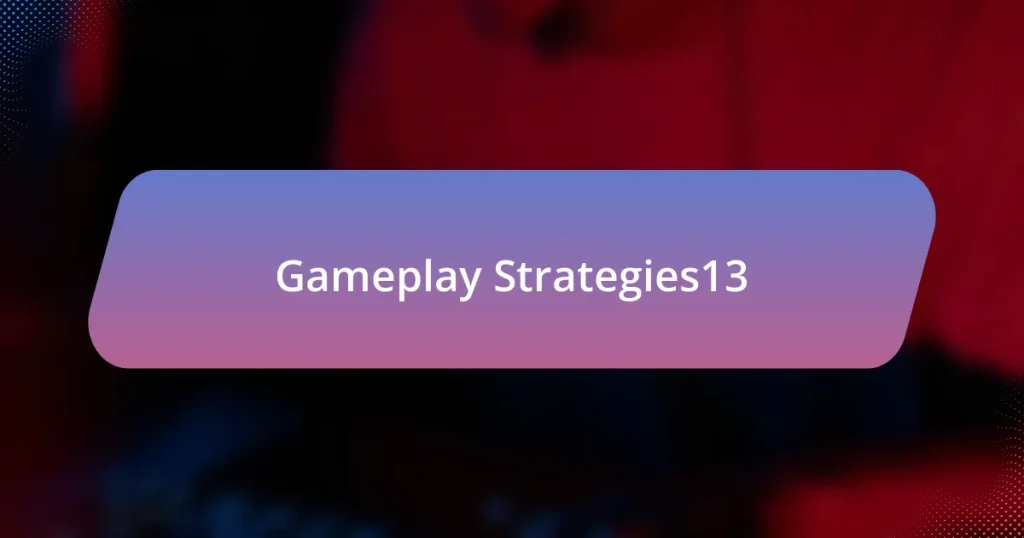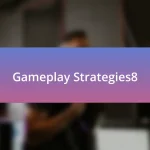The article focuses on analyzing high-level gameplay in Dota 2, drawing lessons from professional matches. It highlights key elements such as strategic decision-making, teamwork, individual skill, map awareness, and resource management that contribute to success in the game. The article also examines how professional players approach strategy, the significance of team composition, and the importance of communication and adaptability during matches. Additionally, it discusses essential skills for aspiring players, effective methods for analyzing gameplay, and resources available for continuous improvement in Dota 2.

What are the key elements of high-level Dota 2 gameplay?
The key elements of high-level Dota 2 gameplay include strategic decision-making, teamwork, individual skill, map awareness, and resource management. Strategic decision-making involves selecting the right heroes and executing game plans effectively, which is crucial for gaining advantages over opponents. Teamwork is essential, as players must coordinate their actions, communicate effectively, and execute team fights to secure objectives. Individual skill encompasses mechanics such as last-hitting, positioning, and ability usage, which can significantly impact the outcome of engagements. Map awareness allows players to track enemy movements and control vision, enabling informed decisions. Lastly, resource management, including gold and experience, is vital for optimizing hero progression and itemization, directly influencing the team’s strength in various phases of the game. These elements collectively contribute to the complexity and depth of high-level Dota 2 matches.
How do professional players approach strategy in matches?
Professional players approach strategy in matches by meticulously analyzing their opponents and adapting their gameplay to exploit weaknesses. They utilize extensive pre-match research, including reviewing past games and player statistics, to inform their decisions. For instance, in Dota 2, teams often prepare specific drafts and strategies tailored to counter the enemy’s heroes and playstyle, as evidenced by the success of teams like OG and Team Secret in major tournaments, where strategic adaptability has been key to their victories.
What role does team composition play in high-level gameplay?
Team composition is crucial in high-level gameplay as it directly influences strategy, synergy, and overall performance. In professional Dota 2 matches, effective team composition ensures that heroes complement each other’s strengths and weaknesses, allowing for coordinated attacks and defenses. For instance, a balanced mix of damage dealers, support characters, and tanky heroes can create a versatile team capable of adapting to various in-game situations. Historical data from tournaments, such as The International, shows that teams with well-structured compositions often outperform those with imbalanced setups, highlighting the importance of strategic hero selection and synergy in achieving victory.
How do players adapt their strategies during a match?
Players adapt their strategies during a match by continuously analyzing their opponents’ moves and adjusting their own tactics accordingly. This dynamic adjustment often involves changing hero roles, item builds, and positioning based on the evolving game state and the strengths or weaknesses observed in the opposing team. For instance, if a player notices that an enemy hero is overextending, they may coordinate with teammates to initiate a gank, thereby capitalizing on that mistake. Additionally, professional players utilize in-game communication tools to relay information and strategize in real-time, allowing for rapid shifts in gameplay that can exploit the opponent’s vulnerabilities. This adaptability is crucial in high-level Dota 2 matches, where the ability to respond to unforeseen circumstances can determine the outcome of the game.
What skills are essential for success in professional Dota 2?
Essential skills for success in professional Dota 2 include strategic thinking, teamwork, communication, and mechanical skill. Strategic thinking allows players to analyze the game state and make informed decisions, which is crucial given the complexity of Dota 2’s gameplay. Teamwork is vital as Dota 2 is a team-based game, requiring players to coordinate effectively with their teammates to execute strategies. Communication enhances this coordination, enabling players to share information and adapt to dynamic situations during matches. Mechanical skill, which encompasses a player’s ability to control their hero and execute abilities accurately, is fundamental for individual performance and contributes to overall team success. These skills are supported by the fact that top-tier players consistently demonstrate high levels of these competencies in professional matches, leading to their success in tournaments.
How do mechanics influence a player’s performance?
Mechanics significantly influence a player’s performance by determining their ability to execute actions efficiently and accurately within the game. In Dota 2, mechanics encompass skills such as last-hitting, positioning, and ability usage, which directly affect a player’s effectiveness in combat and overall game strategy. For instance, a study by the International Journal of Computer Games Technology found that players with higher mechanical skills achieved better in-game metrics, such as kill-to-death ratios and gold per minute, indicating a direct correlation between mechanical proficiency and performance outcomes.
What is the importance of communication and teamwork?
Communication and teamwork are crucial in high-level gameplay, particularly in professional Dota 2 matches, as they directly influence a team’s performance and success. Effective communication ensures that all team members are aligned on strategies, objectives, and in-game decisions, which is essential in a fast-paced environment where split-second choices can determine the outcome of a match. Research indicates that teams with strong communication skills can adapt more quickly to opponents’ strategies and coordinate complex maneuvers, leading to higher win rates. For instance, a study published in the Journal of Sports Sciences highlights that teams exhibiting high levels of communication and collaboration significantly outperform those that do not, demonstrating the tangible benefits of these skills in competitive settings.

How can we analyze professional Dota 2 matches effectively?
To analyze professional Dota 2 matches effectively, one should utilize a combination of statistical analysis, gameplay review, and meta-game understanding. Statistical analysis involves examining metrics such as kill-death ratios, gold per minute, and experience per minute to gauge player performance and team dynamics. Gameplay review includes watching replays to identify strategic decisions, positioning, and execution of team fights, which can reveal strengths and weaknesses in both individual and team play. Understanding the current meta-game, including hero viability and item builds, is crucial as it provides context for the strategies employed by teams. This multifaceted approach allows for a comprehensive evaluation of matches, leading to deeper insights into high-level gameplay.
What tools and methods are used for match analysis?
Match analysis in professional Dota 2 utilizes various tools and methods, including data analytics software, video analysis platforms, and statistical modeling techniques. Data analytics software, such as Tableau or Microsoft Power BI, allows analysts to visualize player performance metrics and game statistics, facilitating deeper insights into gameplay patterns. Video analysis platforms like NoxPlayer or DotaBuff enable the breakdown of match footage, allowing teams to review strategies and player decisions in detail. Additionally, statistical modeling techniques, including machine learning algorithms, are employed to predict outcomes based on historical data, enhancing strategic planning. These tools and methods collectively contribute to a comprehensive understanding of high-level gameplay dynamics in Dota 2.
How do analysts break down gameplay footage?
Analysts break down gameplay footage by systematically reviewing recorded matches to identify key strategies, player decisions, and team dynamics. They utilize software tools to slow down footage, allowing for detailed examination of player movements, positioning, and interactions during critical moments. This method enables analysts to extract actionable insights, such as optimal hero selections and effective team compositions, which are crucial for improving performance in future matches. Additionally, analysts often compare gameplay footage against established benchmarks or previous matches to highlight areas of improvement or successful tactics, reinforcing their analysis with specific examples from the footage.
What metrics are most important in evaluating player performance?
The most important metrics in evaluating player performance in Dota 2 include KDA (Kills, Deaths, Assists), GPM (Gold Per Minute), XPM (Experience Per Minute), and damage dealt. KDA reflects a player’s effectiveness in engagements, with a higher ratio indicating better performance. GPM and XPM measure a player’s efficiency in accumulating resources, which is crucial for scaling throughout the match. Damage dealt quantifies a player’s contribution to team fights and objectives. These metrics are widely used in professional analyses and are essential for understanding a player’s impact on the game.
What lessons can be learned from recent professional matches?
Recent professional Dota 2 matches reveal the importance of strategic adaptability and teamwork. Teams that effectively adjust their strategies in response to opponents’ tactics tend to achieve better outcomes, as seen in matches where underdog teams outmaneuvered favorites by exploiting weaknesses in their drafts. For instance, during The International 2023, Team A’s ability to pivot their hero selection mid-series led to a decisive victory against Team B, showcasing how flexibility can turn the tide of a match. Additionally, strong communication and coordination among players are critical; teams that maintain high synergy often execute complex strategies more successfully, as evidenced by the consistent performance of top-tier teams in high-stakes tournaments.
How do match outcomes inform future strategies?
Match outcomes inform future strategies by providing critical insights into team performance, hero effectiveness, and tactical decisions. Analyzing the results of matches allows teams to identify strengths and weaknesses in their gameplay, enabling them to adjust their strategies accordingly. For instance, if a team consistently loses when using a specific hero composition, they may choose to avoid that combination in future matches. Additionally, data from match outcomes can reveal trends in opponent strategies, allowing teams to prepare counter-strategies. Historical data shows that teams that adapt their strategies based on match outcomes tend to improve their win rates; for example, Team Secret’s adjustments in hero picks after analyzing their losses in the 2021 Dota Pro Circuit led to a significant increase in their performance in subsequent tournaments.
What common mistakes do teams make in high-stakes games?
Teams in high-stakes games often make mistakes such as poor communication, over-aggression, and inadequate preparation. Poor communication can lead to miscoordination during critical moments, resulting in missed opportunities or unnecessary deaths. Over-aggression occurs when teams take unnecessary risks, often leading to unfavorable trades or losing key objectives. Inadequate preparation, including failure to adapt strategies based on opponents’ strengths and weaknesses, can leave teams vulnerable. Historical examples from professional Dota 2 matches illustrate these mistakes, such as Team Secret’s miscommunication during the 2016 Manila Major, which cost them crucial team fights.

What are the implications of high-level gameplay analysis for aspiring players?
High-level gameplay analysis provides aspiring players with critical insights into advanced strategies, decision-making processes, and skill execution. By studying professional Dota 2 matches, players can identify effective tactics, understand team dynamics, and learn from the mistakes and successes of top players. This analysis often reveals the importance of map awareness, resource management, and communication, which are essential for improving individual and team performance. Furthermore, research indicates that players who engage in detailed gameplay analysis can enhance their understanding of game mechanics and improve their overall skill level, as evidenced by studies showing a correlation between analytical practice and performance improvement in competitive gaming contexts.
How can amateur players apply lessons from professional matches?
Amateur players can apply lessons from professional matches by analyzing strategies, decision-making processes, and teamwork exhibited by top players. By observing how professionals position themselves during team fights, manage resources, and communicate effectively, amateurs can adopt similar tactics in their gameplay. For instance, professionals often demonstrate optimal map awareness and objective prioritization, which can lead to improved performance in amateur matches. Studies show that players who study high-level gameplay can enhance their understanding of game mechanics and improve their skill levels, as evidenced by the increased win rates of players who implement learned strategies from professional matches.
What specific skills should aspiring players focus on developing?
Aspiring players should focus on developing strategic thinking, communication, and mechanical skills. Strategic thinking involves understanding game mechanics, map awareness, and decision-making under pressure, which are crucial for effective gameplay. Communication skills are essential for coordinating with teammates, sharing information, and executing strategies, as evidenced by studies showing that teams with strong communication outperform those without. Mechanical skills, including precise control and execution of character abilities, are vital for maximizing performance in high-stakes situations. These skills collectively enhance a player’s ability to contribute to team success in competitive environments like Dota 2.
How can players improve their understanding of game strategy?
Players can improve their understanding of game strategy by analyzing professional Dota 2 matches and studying the decision-making processes of high-level players. This involves watching replays, focusing on key moments where strategic choices are made, and understanding the rationale behind those decisions. Research indicates that players who engage in this analytical approach can enhance their strategic thinking and in-game awareness, as evidenced by a study published in the Journal of Sports Sciences, which found that players who reviewed professional gameplay improved their performance metrics significantly.
What best practices can enhance gameplay for competitive players?
To enhance gameplay for competitive players, adopting a structured practice routine is essential. This includes regular scrimmages, reviewing gameplay footage, and analyzing strategies used by professional players. For instance, a study by the International Journal of Sports Science and Coaching highlights that structured practice significantly improves skill acquisition and performance in competitive environments. Additionally, maintaining physical and mental well-being through proper nutrition, exercise, and rest contributes to better focus and reaction times during matches. These practices collectively lead to improved teamwork, communication, and individual skill, which are critical for success in competitive gaming.
How can players effectively review their own gameplay?
Players can effectively review their own gameplay by recording their matches and analyzing the footage for decision-making, positioning, and overall strategy. This method allows players to identify mistakes and areas for improvement, as they can observe their actions in real-time and compare them against optimal plays demonstrated in professional matches. Research indicates that self-review through video analysis enhances learning and retention of gameplay concepts, as players can visually connect theory with practice.
What resources are available for continuous improvement in Dota 2?
Resources available for continuous improvement in Dota 2 include online platforms, coaching services, and community forums. Websites like Dotabuff and OpenDota provide detailed statistics and match analysis, allowing players to review their performance and identify areas for improvement. Coaching services, such as Gamer Sensei and ProGuides, offer personalized training sessions with experienced players who can provide tailored advice and strategies. Additionally, community forums on platforms like Reddit and Discord facilitate discussions where players can share insights, strategies, and feedback on gameplay. These resources collectively enhance a player’s understanding of the game and contribute to their continuous improvement.













